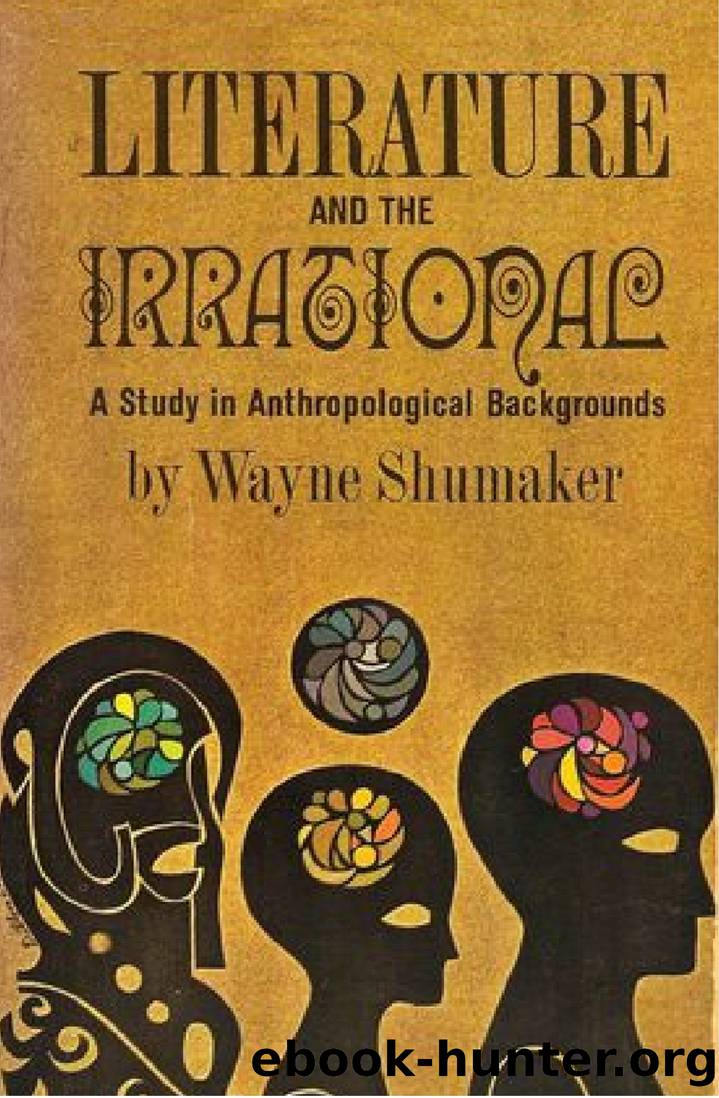Literature And The Irrational; A Study In Anthropological Backgrounds by Shumaker Wayne;

Author:Shumaker, Wayne;
Language: eng
Format: epub
Publisher: Hauraki Publishing
Published: 2016-03-22T00:00:00+00:00
Animals in fiction
An illustration of a more concrete sort of continuity is provided by the treatment of animals in literature. Foxes, birds, horses, and the like have been in fiction from the beginning, although more functional in the Odyssey (Circeâs swine) than in Conradâs Heart of Darkness (which is about the jungle) and in Lucius Apuleiusâ Golden Ass than in Tobias Smollettâs Roderick Random. From time to time they usurp centrality: in Aesopâs Fables, in fairy tales, in nursery rhymes, in moving-picture cartoons, in stories like Black Beauty and Shaggycoat the Beaver, in the fourth book of Gulliverâs Travels, in George Orwellâs Animal Farm, in Chaucerâs Nunâs Priestâs Tale, in a recent series of films about Francis, the Talking Mule. Whenever this happens, they possess strikingly human traitsânot only human feelings and some power of reason but often the capability of human speech. When they remain outwardly animal, they nonetheless retain vestigial human characteristics. A dog in a realistic novel may look bored, sniff critically at his food, show anxiety, resist an unwise purpose of his master. To non-genetic theory, it may seem that animals are used as deliberate surrogates for people, as âsymbols.â The roots of the practice, however, lie deeper, for in savage thought there is no dichotomy between brutes and men. Commerce between them is easy, and transformations from one form to the other are common.
The most familiar proof that the animal and human realms overlap is furnished by the widespread practice of totemism, which everywhere rests on a supposed blood relationship of the clan to its totem animal. In more advanced culturesâfor example, the ancient Egyptianâthe gods were represented in the forms of animals and birds. Anthropomorphic deities (Zeus, Odin) often turned themselves into animals. Again, primitive hunting rituals assume what has been called âthe solidarity of lifeâ among all animate species. The co-operation of the prey may be implored; the speaking of its name may be tabooed lest it should take alarm; if the hunt is successful, thanks may be offered to the victim for submitting itself to death, and its pardon implored for the further violence of cooking and eating it.{281} Beneath all these strange customs is the belief that animals have an intelligence similar to manâs and magical power possibly greater.{282} The basis of the practices appears to be a tendency of primitive man to read his own nature into objects other than himself, as a child projects its mentality into dolls and toys. The fact that animals were never heard actually to talk or seen to behave rationally had not the slightest effect on the belief. The mind has ways of getting round such difficulties: rationalization in the adult Westerner, something less complicated but harder to analyze in the child and in primitive men.
In the face of this evidence, there is not (I think) much doubt that an archaic mental attitude toward animals has been established as a convention in literature. When vitalistic assumptions began to decay, the old plots continued to be imitated.
Download
This site does not store any files on its server. We only index and link to content provided by other sites. Please contact the content providers to delete copyright contents if any and email us, we'll remove relevant links or contents immediately.
The Vikings: Conquering England, France, and Ireland by Wernick Robert(79939)
Ali Pasha, Lion of Ioannina by Eugenia Russell & Eugenia Russell(40158)
The Conquerors (The Winning of America Series Book 3) by Eckert Allan W(37149)
The Vikings: Discoverers of a New World by Wernick Robert(36923)
Cecilia; Or, Memoirs of an Heiress — Volume 1 by Fanny Burney(32437)
Cecilia; Or, Memoirs of an Heiress — Volume 2 by Fanny Burney(31873)
Cecilia; Or, Memoirs of an Heiress — Volume 3 by Fanny Burney(31857)
Empire of the Sikhs by Patwant Singh(22978)
The Secret History by Donna Tartt(18853)
Hans Sturm: A Soldier's Odyssey on the Eastern Front by Gordon Williamson(18488)
Cat's cradle by Kurt Vonnegut(15189)
Pimp by Iceberg Slim(14398)
Sapiens: A Brief History of Humankind by Yuval Noah Harari(14256)
Talking to Strangers by Malcolm Gladwell(13231)
Norse Mythology by Gaiman Neil(13211)
Leonardo da Vinci by Walter Isaacson(13189)
4 3 2 1: A Novel by Paul Auster(12289)
Underground: A Human History of the Worlds Beneath Our Feet by Will Hunt(12027)
The Radium Girls by Kate Moore(11930)
